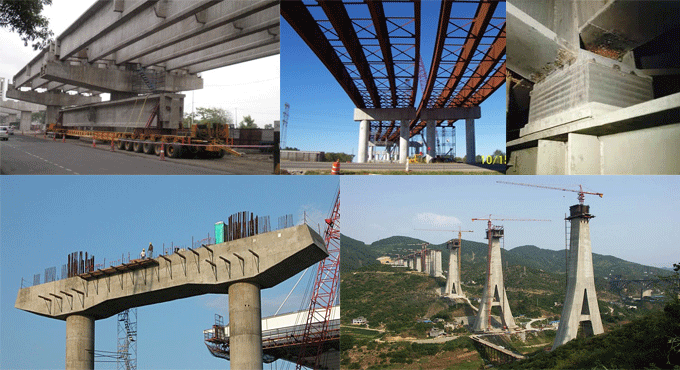TUTORIALS
Main Components of Bridges (Concrete Span Bridge)

Although, there are several categories of bridges, this article is about the main components of the bridges. Each bridge engineer must possess a sound understanding of the several terms utilized at the time of the bridge blueprint procedure.
At the time of the design procedure, each bridge can be categorized generally into three segments.
Superstructure: It is the component of the construction that upholds movement and comprises floor, block and beams. Each component of the bridge that is coupled with a sustaining arrangement can be categorized as a superstructure.
Substructure: It is the component of the structure (such as pillars and supports) that upholds the superstructure and shifts the constructional weight to the bases.
Foundation: It is the part that shifts loads of the substructure to the carriage level. As per the geotechnical characteristics of the carriage level, foundations that transfer loads to rocks at large depth or foundations that transfer loads to the uppermost strata of the ground are chosen.
Generally, foundations prepared underneath the level attained by water in tank (water level) of bridges and pile foundations are acknowledged for bridge foundations.
Five main components of a RC Bridge:
Beam or Girder: Girder or beam is the component of superstructure that is below bending beside the distance. It’s the component that carries the weight and upholds the floor.
Span is the length among support spots (for example, columns, and support). Deck is bridge level that straightforwardly carries movement weight. Deck carries weight to the Girders on the basis of the flooring component.
Bearing: Bearing shifts weight from the joists to the pillar caps. Bearing is a part that upholds component of the bridge and that carries powers from the component to a different component of the construction at the same time as allowing forked and/or lineal shift among components.
Bearing / Pier Cap: Headstock or Pier Cap is the part that carries weight out of the superstructure toward the piers. Pier can offer adequate spaces for the Bridge joists and distribute the weight out of the bearings toward the columns.
Piles and pillar cap: Pile foundation is the widely utilized foundation arrangement for bridges. Pile is a slight compression component pulled into or created in the ground to oppose weight. A reinforced concrete weight formed nearby the top of a collection of piles to make sure that they work collectively and spread the weight with them is called pillar cap.
Pier: Pier is the component of the substructure that upholds the superstructure toward the last part of the length and that carries weight upon the superstructure toward the bases. Relying on look, area, location and financial conditions, several forms of piers are chosen to go with the prerequisites. Generally, prestressed concrete or reinforced concrete is chosen for the creation of vertical supports.
Article Source: civildigital.com

